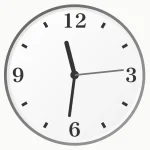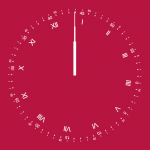| Author: | Amitrai011 |
|---|---|
| Views Total: | 237 views |
| Official Page: | Go to website |
| Last Update: | March 30, 2023 |
| License: | MIT |
Preview:
Description:
A stylish Neumorphism-style analog clock app icon written in CSS/CSS3 and a little bit of JavaScript.
How to use it:
1. The required HTML structure for the analog clock.
<div class="clock">
<div class="numbers">
<span class="twelve"><b>12</b></span>
<span class="three"><b>3</b></span>
<span class="six"><b>6</b></span>
<span class="nine"><b>9</b></span>
<div class="time hrs"><i></i></div>
<div class="time min"><i></i></div>
<div class="time sec"><i></i></div>
</div>
</div>2. The necessary CSS styles. Copy and paste the following snippets in your project.
.clock {
display: flex;
justify-content: center;
align-items: center;
width: 250px;
height: 250px;
border-radius: 50px;
background-color: #E5E0FF;
cursor: pointer;
position: relative;
box-shadow: 30px 30px 30px -10px rgba(0, 0, 0, 0.15),
inset 15px 15px 10px rgba(255, 255, 255, 0.75),
-15px -15px 35px rgba(255, 255, 255, 0.55),
inset -1px -1px 10px rgba(0, 0, 0, 0.2);
}
.clock::before {
position: absolute;
content: "";
width: 4px;
height: 4px;
border-radius: 50%;
background-color: #e91e63;
z-index: 2;
box-shadow: 0 0 0 1px #e91e63,
0 0 0 3px #fff,
0 0 5px 5px rgba(0, 0, 0, 0.15);
}
.clock .numbers {
position: absolute;
border-radius: 50%;
background-color: #152b4a;
top: 35px;
left: 35px;
bottom: 35px;
right: 35px;
box-shadow: 5px 5px 15px #152b4a,
inset 5px 5px 5px rgba(255, 255, 255, 0.55),
-6px -6px 10px rgba(255, 255, 255, 1);
}
span {
position: absolute;
text-align: center;
top: 5px;
right: 5px;
bottom: 5px;
left: 5px;
color: #fff;
font-size: 1.25em;
}
.twelve {
/* Not Mandatory */
transform: rotate(360deg);
}
.three {
transform: rotate(90deg);
}
.six {
transform: rotate(180deg);
}
.nine {
transform: rotate(270deg);
}
b {
font-weight: 700;
display: block;
}
.three b {
transform: rotate(-90deg);
}
.six b {
transform: rotate(-180deg);
}
.nine b {
transform: rotate(-270deg);
}
.clock .numbers::before {
position: absolute;
content: "";
top: 35px;
left: 35px;
bottom: 35px;
right: 35px;
background: linear-gradient(#2196f3, #e91e63);
border-radius: 50%;
animation: rotateAnimation 2s linear infinite;
}
.clock .numbers::after {
position: absolute;
content: "";
top: 38px;
left: 38px;
bottom: 38px;
right: 38px;
background: #152b4a;
border-radius: 50%;
}
.time {
position: absolute;
top: 0;
right: 0;;
bottom: 0;
left: 0;
border-radius: 50%;
display: flex;
justify-content: center;
z-index: 1;
}
.time i {
position: absolute;
width: 3px;
background-color: #fff;
height: 50%;
transform-origin: bottom;
transform: scaleY(0.55);
}
.hrs i {
transform: scaleY(0.3);
width: 4px;
}
.min i {
transform: scaleY(0.45);
}
.sec i {
width: 2px;
transform: scaleY(0.55);
background-color: #e91e63;
box-shadow: 0 30px 0 #e91e63;
}
@keyframes rotateAnimation {
0% {
transform: rotate(0deg);
}
100% {
transform: rotate(360deg);
}
}3. Update the clock using JavaScript.
const hours = document.querySelector(".hrs");
const minutes = document.querySelector(".min");
const seconds = document.querySelector(".sec");
function setTime() {
let now = new Date();
let hr = now.getHours() * 30;
let min = now.getMinutes() * 6;
let sec = now.getSeconds() * 6;
hours.style.transform = `rotateZ(${hr+(min / 12)}deg)`;
minutes.style.transform = `rotateZ(${min}deg)`;
seconds.style.transform = `rotateZ(${sec}deg)`;
}
setInterval(setTime);









